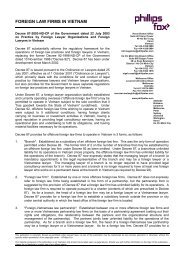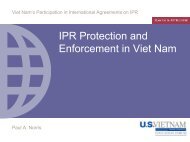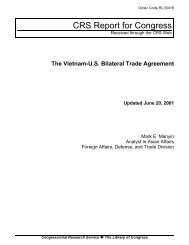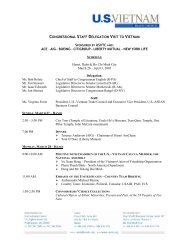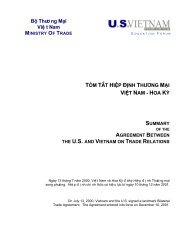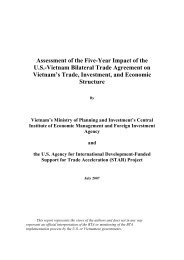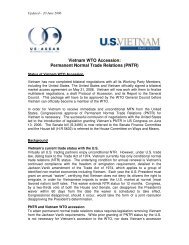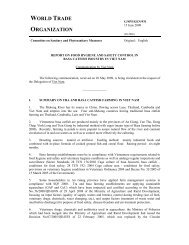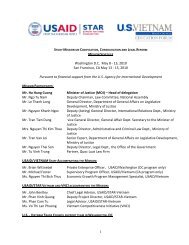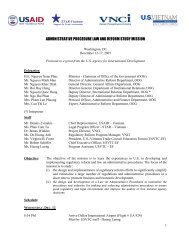Climate risks and adaptation in Asian coastal megacities: A synthesis
Climate risks and adaptation in Asian coastal megacities: A synthesis
Climate risks and adaptation in Asian coastal megacities: A synthesis
- No tags were found...
Create successful ePaper yourself
Turn your PDF publications into a flip-book with our unique Google optimized e-Paper software.
2.1.2 L<strong>and</strong> Subsidence 2.1.2 L<strong>and</strong> SubsidenceFrom observed data, From the observed average l<strong>and</strong> data, subsidence the average rate l<strong>and</strong> <strong>in</strong> subsidence the Bangkok rate Metropolitan <strong>in</strong> the Bangkok Region Metropolitan (BMR) Region (BMR)has gradually reduced has gradually from 10 cm reduced per year from to 101-2 cm cm per per year year to from 1-2 cm 1978 per to year 2007. from Furthermore, 1978 to 2007. Furthermore,dur<strong>in</strong>g the last 5 years dur<strong>in</strong>g (2002-2007), the last 5 years the average (2002-2007), l<strong>and</strong> subsidence the average rate l<strong>and</strong> has subsidence reduced to rate 0.97 has cm reduced per to 0.97 cm peryear. Therefore, it year. is expected Therefore, that it the is expected l<strong>and</strong> subsidence that the rate l<strong>and</strong> would subsidence reduce rate by 10% would per reduce year. by Thus, 10% per year. Thus,the accumulated l<strong>and</strong> the accumulated subsidence dur<strong>in</strong>g l<strong>and</strong> subsidence 2002-2050 dur<strong>in</strong>g (48 years) 2002-2050 would (48 spatially years) vary would from spatially 5 to 30 vary from 5 to 30cm depend<strong>in</strong>g on location cm depend<strong>in</strong>g as shown on location <strong>in</strong> Figure as 2.1-3. shown <strong>in</strong> Figure 2.1-3.Figure 3.2 ■ L<strong>and</strong> Elevations, 2002 versus 2050 L<strong>and</strong> Subsidence640000660000640000680000660000700000680000640000700000660000640000680000660000700000680000700000!(Pathum Thani!(Pathum Thani!(Pathum Thani!(Pathum Thani!(Nonthaburi!(Bangkok!(Samut Prakan14800001480000150000015000001520000152000015400001540000!(Nonthaburi!(Bangkok!(Samut Prakan14800001480000150000015000001520000152000015400001540000!(Nonthaburi!(Bangkok!(Samut Prakan14800001480000150000015000001520000152000015400001540000!(Nonthaburi!(Bangkok!(Samut Prakan14800001480000150000015000001520000152000015400001540000640000660000640000680000660000700000680000640000700000660000640000680000660000700000680000700000Legend!( Prov<strong>in</strong>ceProv<strong>in</strong>ce BoundaryRiver/Canal Network-1 - 00 - 11 - 2Legend8 - 10 !( Prov<strong>in</strong>ce10 - 15 Prov<strong>in</strong>ce Boundary15 - 20 River/Canal Network-1 - 00 - 11 - 28 - 10Ê10 - 150 1.5 3 6 9 1215 - 20Legend!( Prov<strong>in</strong>ceProv<strong>in</strong>ce BoundaryÊ-1 - 00 - 1River/Canal 0 1.5 Network 3 6 9 121 - 2Legend8 - 10 !( Prov<strong>in</strong>ce10 - 15 Prov<strong>in</strong>ce Boundary15 - 20 River/Canal Network-1 - 00 - 11 - 2Ê8 - 1010 - 150 1.5 3 6 9 1215 - 20Ê0 1.5 3 6 9 12Elevation (m.MSL)-7 - -5-5 - -3-3 - -12 - 33 - 44 - 55 - 820 Elevation - 25 (m.MSL)25 - 35-7 - -5-5 - -3-3 - -12 - 320 - 25Kilometers3 - 425 - 35L<strong>and</strong> Elevation <strong>in</strong> 20024 - 5(Surveyed 5 - 8 benchmark)Elevation (m.MSL) Kilometers-7 - -5L<strong>and</strong> Elevation <strong>in</strong> 2002-5 - -3(Surveyed benchmark)-3 - -12 - 33 - 44 - 55 - 820 Elevation - 25 (m.MSL)25 - 35-7 - -52 - 320 - 25 KilometersKilometers3 - 425 - 35L<strong>and</strong> Elevation <strong>in</strong> 2050 L<strong>and</strong> Elevation <strong>in</strong> 2050-5 - -34 - 5(Forecasted -3 - -1 l<strong>and</strong> 5 - 8 subsidence) (Forecasted l<strong>and</strong> subsidence)Source: Panya Consultants (2009).Source: Royal Thai Survey Source: Department Royal Thai (RTSD) Survey <strong>and</strong> Department Panya Consultants’ (RTSD) <strong>and</strong> forecast Panya Consultants’ forecastdistribution patterns (1995). There is an implicitassumption that the underly<strong>in</strong>g variability (tim<strong>in</strong>g<strong>and</strong> location) will rema<strong>in</strong> the same <strong>in</strong> 2050. This isconservative <strong>in</strong> the sense that <strong>in</strong>creased variability(worse floods <strong>and</strong> droughts) around the mean wouldgenerate greater losses than estimated <strong>in</strong> the study.Ma<strong>in</strong> F<strong>in</strong>d<strong>in</strong>gs fromHydrological Analysis <strong>and</strong>GIS Mapp<strong>in</strong>g for BangkokFlood-prone area likely to <strong>in</strong>crease <strong>in</strong>Bangkok <strong>in</strong> the futureFigure 2.1-3 L<strong>and</strong> Figure Elevation 2.1-3 <strong>in</strong> L<strong>and</strong> 2002 Elevation <strong>and</strong> 2050 <strong>in</strong> due 2002 to L<strong>and</strong> 2050 Subsidence due to L<strong>and</strong> Subsidence2.2 CLIMATE 2.2 CLIMATE2.2.1 General 2.2.1 General2-2rema<strong>in</strong> under water for over a month. The <strong>in</strong>creaseis likely to be <strong>in</strong> the western areas, where exist<strong>in</strong>gflood protection <strong>in</strong>frastructure is likely to be <strong>in</strong>sufficient.There is also an <strong>in</strong>crease <strong>in</strong> the maximumwater depth between the base year <strong>and</strong> 2050 forevents of different return periods. Figure 3.3 forexample, shows a comparison of the maximumdepths of flood<strong>in</strong>g for the 1-<strong>in</strong>-30-year flood under2008 <strong>and</strong> the 2050 A1FI scenario. The implication isthat the people liv<strong>in</strong>g <strong>in</strong> Bangkok will be fac<strong>in</strong>g morefrequent events that significantly disrupt daily life.2-2A flood frequency graph obta<strong>in</strong>ed by plott<strong>in</strong>gthe <strong>in</strong>undated area versus return frequency for theBangkok City case study results for the 2008 <strong>and</strong> 2050The climate of the The Chao climate Phraya of River the Chao Bas<strong>in</strong> Phraya belongs River to the Bas<strong>in</strong> tropical belongs monsoon. to the tropical The average monsoon. annual The average annualra<strong>in</strong>fall over the bas<strong>in</strong> ra<strong>in</strong>fall is 1,130 over the mm, bas<strong>in</strong> vary<strong>in</strong>g is 1,130 from mm, 1,000 vary<strong>in</strong>g to 1,600 from mm 1,000 <strong>and</strong> to register<strong>in</strong>g 1,600 mm higher <strong>and</strong> register<strong>in</strong>g <strong>in</strong> the higher <strong>in</strong> thenortheastern region northeastern of bas<strong>in</strong>. region Accord<strong>in</strong>g of the to bas<strong>in</strong>. the ra<strong>in</strong>fall Accord<strong>in</strong>g pattern, to the about ra<strong>in</strong>fall 85% pattern, of the average about 85% annual of the average annualra<strong>in</strong>fall occurs between ra<strong>in</strong>fall May occurs <strong>and</strong> between October. May Tropical <strong>and</strong> October. cyclones Tropical occur between cyclones September occur between <strong>and</strong> September <strong>and</strong>October <strong>and</strong> may October strike the <strong>and</strong> bas<strong>in</strong>. may In strike this the case, bas<strong>in</strong>. ra<strong>in</strong>fall In this cont<strong>in</strong>ues case, ra<strong>in</strong>fall for a long cont<strong>in</strong>ues period for of time a long <strong>in</strong> period a of time <strong>in</strong> arelatively wide area. relatively The peak wide river area. discharge The peak is river registered discharge <strong>in</strong> October, is registered the end <strong>in</strong> of October, the ra<strong>in</strong>y the season, end of the ra<strong>in</strong>y season,<strong>and</strong> severe flood <strong>and</strong> damage severe may flood arise damage with high may tide arise <strong>in</strong> with this period. high tide The <strong>in</strong> mean this period. temperature The mean ranges temperature rangesfrom 26 o C to 31 o C. from Its 26 maximum o C to 31 o temperature C. Its maximum is <strong>in</strong> temperature April <strong>and</strong> its is m<strong>in</strong>imum April <strong>and</strong> is <strong>in</strong> its December. m<strong>in</strong>imum The is <strong>in</strong> December. Theevaporation (Class-A evaporation Pan) <strong>in</strong> (Class-A the bas<strong>in</strong> Pan) is normally <strong>in</strong> the bas<strong>in</strong> at its is highest normally <strong>in</strong> April at its <strong>and</strong> highest lowest <strong>in</strong> April <strong>in</strong> October <strong>and</strong> lowest <strong>in</strong> Octoberwith an average annual with an value average of about annual 1,700 value mm. of about 1,700 mm.The hydrological analysis shows that for events ofdifferent return periods, the area <strong>in</strong>undated will<strong>in</strong>crease <strong>in</strong> 2050 for both the B1 <strong>and</strong> the A1FI scenarios(Table 3.4).For <strong>in</strong>stance, the current (2008) estimated annual<strong>in</strong>undated area <strong>in</strong> Bangkok <strong>and</strong> Samut Prakarn isabout 550 km 2 , which will <strong>in</strong>crease to 734 km 2 <strong>in</strong> 2050under the A1FI scenario for a 1-<strong>in</strong>-30-year flood. Thatis an <strong>in</strong>crease of 184 kms, or approximately a 30 percent<strong>in</strong>crease <strong>in</strong> the area <strong>in</strong>undated. The <strong>in</strong>undationcould be for vary<strong>in</strong>g depths <strong>and</strong> vary<strong>in</strong>g number ofdays, but about 7 percent of these prov<strong>in</strong>ces couldTable 3.4 ■ Bangkok Inundated Areaunder Current Conditions<strong>and</strong> Future ScenariosFrequency2008(km 2 )Scenario2050 B1(km 2 )2050 A1FI(km 2 )1/100-year 737 893 9271-<strong>in</strong>-30-year 550 719 7341-<strong>in</strong>-10-year 359 481 518Source: Panya Consultants (2009), Appendix k, Table K2.4-1.28 | <strong>Climate</strong> Risks <strong>and</strong> Adaptation <strong>in</strong> <strong>Asian</strong> Coastal Megacities: A Synthesis Report



